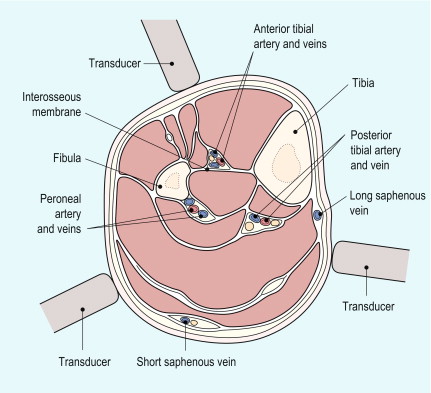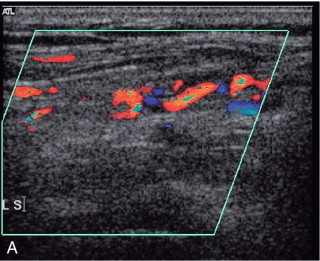Physical Address
304 North Cardinal St.
Dorchester Center, MA 02124
Atheroma occurs to different degrees in different parts of an individual’s cardiovascular system and the lower limb arteries are particularly prone to the development of atherosclerosis. Approximately 2% of adults in late middle age in Western countries have intermittent claudication and each year in England and Wales around 50 000 patients are admitted to hospital with a diagnosis of peripheral arterial disease; 15 000 of these will require amputation. There are many factors which may influence the development of disease and, in general terms, the prevalence of peripheral vascular disease detected by non-invasive procedures is about three times greater than the prevalence of intermittent claudication. This chapter concentrates on the use of ultrasound in the assessment of disease in the lower limb arteries, as this is the area where most work is generated, but the value of ultrasound in the investigation of a variety of upper limb arterial disorders is also discussed.
The main indications for performing Doppler ultrasound of the arteries of the upper and lower limbs are given in Box 4-1 . The most common indication is the assessment of patients with ischaemic symptoms of the lower limb in order to determine if they are likely to benefit from angioplasty or a bypass graft. The ultrasound findings provide information on the extent and severity of disease; even in patients with limb-threatening ischaemia ultrasound is a useful first-line investigation that can provide the surgeon with all the information that is required for patient management. In many cases ultrasound will provide sufficient information for management decisions to be reached. In other cases, if further information is required, the subsequent magnetic resonance angiography (MRA)/computed tomography angiography (CTA)/arteriogram can be tailored appropriately. Ultrasound provides an accurate assessment of the major arteries which allows distinction between patients with significant peripheral arterial disease and those without. At the other end of the spectrum, patients with atypical symptoms that might be due to ischaemia can be examined to exclude the presence of significant arterial disease.
Assessment of disease in patients with ischaemic symptoms of the upper or lower limb
Follow-up of bypass graft procedures
Follow-up of angioplasty procedures
Diagnosis and follow-up of aneurysms of the peripheral arteries
Diagnosis and treatment of false aneurysms
Diagnosis of pulsatile lumps
Assessment of dialysis shunts
A variety of problems can occur with surgically inserted bypass grafts, especially in the first year after the operation. Ultrasound provides accurate information about any problems that may develop in relation to these bypass grafts. Similarly, patients in whom angioplasty has been undertaken can be followed with ultrasound to confirm residual patency, identify re-stenosis and assess improvements to flow following the procedure.
The assessment of pulsatile masses in relation to the arteries of the upper and lower limbs can be performed rapidly and easily using ultrasound. Aneurysms can be distinguished from non-vascular masses which lie adjacent to the artery. The complications of catheterisation procedures, including haematomas, arteriovenous fistulae and false or pseudoaneurysms, can be assessed and differentiated; in many cases, pseudoaneurysms can be treated under ultrasound control, thereby removing the need for a surgical procedure.
Arteriovenous fistulae created for haemodialysis can be examined using ultrasound, allowing identification of complications associated with stenosis or occlusion, as well as estimation of blood flow through the shunt, particularly if this is thought to be inadequate or excessive (see Chapter 7 ).
The arteries of the lower limb arise at the bifurcation of the abdominal aorta ( Fig. 4-1 ), the common iliac arteries run down the posterior wall of the pelvis and divide into the internal and external iliac arteries in front of the sacroiliac joint. The internal iliac artery continues down into the pelvis and is difficult to demonstrate with transabdominal ultrasound, although transvaginal or transrectal scanning will show some of its branches. The external iliac artery continues around the side of the pelvis to the level of the inguinal ligament, it lies anteromedial to the psoas muscle and is normally superficial to the external iliac vein.

The common femoral artery runs from the inguinal ligament to its division into superficial and deep femoral arteries in the upper thigh; this division is usually 3–6 cm distal to the inguinal ligament. The deep femoral artery, or profunda femoris artery, passes posterolaterally to supply the major thigh muscles. The importance of the profunda femoris lies in its role as a major collateral pathway in patients with significant superficial femoral artery disease. Several other branches arise from the external iliac, common femoral and profunda femoris arteries and occasionally one of these may be mistaken for the profunda femoris artery, especially if it is enlarged as a collateral supply.
The superficial femoral artery (also referred to as the femoral artery) passes downwards along the anteromedial aspect of the thigh lying anterior to the vein; in the lower third of the thigh it passes into the adductor canal, deep to sartorius and the medial component of quadriceps femoris. Passing posteriorly behind the lower femur it enters the popliteal fossa and becomes the popliteal artery, which lies anterior to the popliteal vein and gives off several branches, the largest of which are the superior and inferior geniculate arteries. Below the knee joint the popliteal artery divides into the anterior tibial artery and the tibioperoneal trunk, although the exact level of the division may vary; after 2–4 cm the latter divides into the posterior tibial artery and the peroneal artery.
The anterior tibial artery passes forwards through the interosseous membrane between the fibula and tibia. It then descends on the anterior margin of the membrane, deep to the extensor muscles on the anterolateral aspect of the calf ( Fig. 4-2 ). At the ankle it passes across the front of the joint to become the dorsalis pedis artery of the foot which runs from the front of the ankle joint to the proximal end of the first intertarsal space where it gives off metatarsal branches and passes through the first intertarsal space to unite with the lateral plantar artery and form the plantar arterial arch.

The posterior tibial artery passes down the deep medial aspect of the calf to pass behind the medial malleolus, after which it divides into the medial and lateral plantar arteries of the foot; the lateral plantar artery joins with the dorsalis pedis artery in the plantar arch.
The peroneal artery passes down the calf behind the tibia and interosseous membrane and divides into several periarticular branches behind the ankle joint. The size of the calf arteries can be quite variable, the posterior tibial artery is the least variable in calibre but the anterior tibial and peroneal arteries may vary considerably in calibre and overall length in the calf. The arterial supply to the foot is not normally examined but if a bypass procedure to the pedal arteries is being considered then the dorsalis pedis and posterior tibial artery and its plantar branches should be assessed.
A full scan of the lower limb arteries can be time consuming. In some cases a full scan from aortic bifurcation to the ankle or foot is required but in other cases the examination can be tailored to specific levels depending on the diagnostic information required. It is therefore useful if the diagnostic question can be clearly defined, so that the most appropriate examination can be performed.
The examination begins with the patient lying supine on the couch. The main steps in the examination are given in Box 4-2 . A linear array transducer is used; usually 5–12 MHz depending on the performance of the ultrasound system and the build of the patient, lower frequencies may be required to examine the arteries in the adductor canal or in large patients. The distal external iliac/common femoral artery is located using colour Doppler as it leaves the pelvis under the inguinal ligament lateral to the femoral vein. Even if flow appears normal on colour Doppler and there is no evidence of local disease, a spectral Doppler trace should be recorded, as changes in this may indicate the presence of significant disease proximally, necessitating a careful direct examination of the iliac vessels. The bifurcation of the common femoral artery into the profunda femoris and superficial femoral arteries is then examined using colour and spectral Doppler. The profunda femoris artery should be examined over its proximal 5 cm, especially in patients with severe superficial femoral disease, in order to assess the amount of collateral flow, or its potential value as a graft origin or insertion point.
Patient supine: scan common femoral, proximal profunda and superficial femoral artery down to adductor canal
Patient decubitus: scan adductor canal, popliteal artery to bifurcation and tibioperoneal trunk, scan posterior tibial and peroneal arteries
Patient supine: scan anterior tibial arteries. Scan iliac arteries and infrarenal aorta
The superficial femoral artery is then followed along the length of the thigh using colour Doppler. It is often better to move the transducer in sequential steps, rather than sliding it down the thigh, as most machines require a few frames of sampling at each position to provide a steady image. In addition, the moving transducer generates colour Doppler noise over the image, obscuring vascular details. Doppler spectra are obtained as necessary at points of possible disease. Even in the absence of colour Doppler abnormalities, it is good practice to obtain routine spectral assessments from the superficial femoral artery in the upper, middle and lower thigh, in order to confirm that there is no alteration in the waveform that might suggest disease. Sometimes the artery is difficult to see on colour or power Doppler as the signals are weak or absent. In these cases the artery may be visible by virtue of calcified plaques in the wall of the vessel. Alternatively, the superficial femoral vein, lying behind the artery, can be used as a guide to the position of the artery and spectral Doppler used to demonstrate the presence or absence of arterial flow. Echo-enhancing agents can be used if there is any continuing uncertainty concerning the patency of the artery.
There are three indirect signs of significant disease which might be apparent during the examination and which should prompt a careful review if a cause for these changes has not been identified.
Colour Doppler may show the presence of collateral vessels in the muscles of the thigh ( Fig. 4-3A ).

Collateral vessels may be seen leaving the main artery ( Fig. 4-3B ).
The character of the spectral waveform may show a change between two levels, indicating a segment of disease somewhere between the two points of measurement.
The patient is then turned into a lateral decubitus position so that the medial aspect of the leg being examined is uppermost ( Fig. 4-4 ). This position is better than the prone position as it allows access in continuity to the lower superficial femoral artery, the adductor canal area, the popliteal region and the medial calf. The region of the adductor canal must be examined with great care as it is a site where a short-segment stenosis or occlusion may be present, and this section of the vessel can be difficult to visualise as it passes deep to the thigh muscles. In some cases the use of a lower scanning frequency may help visualisation. The superficial femoral artery is examined as far down as it can be followed on the medial aspect of the thigh; the popliteal artery is then located in the popliteal fossa and followed superiorly. In difficult cases a mark can be put on the skin of the medial thigh to show the lowest segment of vessel visualised in the supine position; the popliteal artery is then followed superiorly in the decubitus position until the transducer reaches the level of the skin mark, ensuring that the vessel has been examined in continuity. The popliteal artery is then examined and followed down to the point of division into the tibioperoneal trunk and anterior tibial artery.

The complexity of the assessment of the calf arteries depends on the clinical situation. If the examination is to exclude significant proximal disease that would benefit from angioplasty or bypass grafts, then it is usually sufficient to assess the three calf arteries at the upper and mid-calf level, recording whether they are patent or not, in order to provide some assessment of the state of the distal run-off. In other cases a more detailed examination is required to clarify changes seen on MRA/arteriography, or if a distal insertion point for a bypass graft is being sought. The increased sensitivity of power Doppler is useful in detecting weak signals from small or diseased but patent vessels.
The posterior tibial artery is usually the easier of the two branches of the tibioperoneal trunk to locate. Often it can be located by placing the transducer in a longitudinal position on the medial aspect of the mid-calf area behind the tibia, using colour or power Doppler to show the course of the vessel, which can then be followed up and down the calf. In obese or oedematous legs, or if blood flow is impaired by disease, the posterior tibial artery and the other calf arteries may be difficult to locate. Scanning with colour Doppler in the transverse plane using some angulation towards the head or feet may show the relative positions of the posterior tibial and peroneal arteries. Alternatively, the associated veins can be used to identify the region of the relevant artery: squeezing the foot or lower calf will augment flow in the deep veins, allowing these to be identified in either a longitudinal or transverse scan plane. The posterior tibial artery can also be located as it passes behind the medial malleolus, where its position is constant, and then followed back up the leg.
The peroneal artery runs more deeply down the calf than the posterior tibial artery, lying closer to the posterior aspect of the tibia and the interosseous membrane. It can be examined from several approaches: firstly from a posteromedial approach similar to that used for the posterior tibial artery; secondly, it can often also be seen from the anterolateral approach used for the anterior tibial artery as it runs behind the interosseous membrane ( Fig. 4-2 ); thirdly, a posterolateral approach may be of value in some cases.
The anterior tibial artery is examined from an anterolateral approach through the extensor muscles lying between the tibia and fibula. The two bones can be identified on transverse scanning and the interosseous membrane located passing between them. The anterior tibial artery lies on the membrane and can be located using colour Doppler in either the longitudinal or transverse plane. It usually lies nearer the fibula than the tibia ( Fig. 4-2 ).
The foot vessels are not usually examined but the dorsalis pedis artery may be examined in front of the ankle joint before it passes deep to the metatarsals; this is indicated if the artery is being considered for the insertion of a femorodistal graft.
The advent of power Doppler and echo-enhancing agents has extended the role of ultrasound in the assessment of vascular disease. In the proximal lower limb and iliac vessels, the location of the vessel and confirmation of occluded segments has been made easier and, in the distal part of the leg, they make assessment of the smaller vessels of the calf and foot easier. However, more work is required to evaluate further their role.
Examination of the iliac vessels is carried out as part of a general survey of the lower limb arteries, or if the clinical picture suggests a need to confirm or exclude disease affecting these vessels, or if the Doppler findings at the groin suggest the likelihood of significant proximal disease. The ease with which they can be visualised depends on the build of the patient and the amount of bowel gas present. It is usually necessary to use a 3–5 MHz transducer for satisfactory visualisation. Some examiners will prepare patients for iliac Doppler examinations with laxatives and low-residue diets if it is considered likely that these vessels will be examined, although most centres do not do this routinely.
The external iliac artery can be followed up from the groin for a variable distance; the vein, lying behind the artery, can be used to identify the probable location of the artery if this is not apparent. Colour or power Doppler may also help locate the vessel, even if it is not visible on the real-time image. Superiorly, the common iliac artery can be identified arising at the aortic bifurcation and then followed distally. Firm pressure with the transducer will displace intervening amounts of bowel gas to a large extent, although care must be taken not to compress the artery and produce a false impression of a stenosis. The internal iliac artery may be seen arising from the common iliac artery and passing deeply into the pelvis. This is a useful landmark as visualisation of the internal iliac artery origin, on tracking both the external iliac artery upwards and the common iliac artery downwards, means that the iliac arteries have been examined in their entirety.
The orientation of the iliac vessels as they pass round the pelvis and the use of sector or curved-array transducers can lead to problems with beam–vessel geometry and obtaining satisfactory angles of insonation. However, careful attention to positioning the transducer will usually allow an appropriate angle to be obtained.
Become a Clinical Tree membership for Full access and enjoy Unlimited articles
If you are a member. Log in here